Development, Critical Evaluation, and Proposed Framework: End-of-Life Vehicle Recycling in India
Abstract
1. Introduction
2. Methodology
2.1. Research Design and Sampling
2.2. Qualitative Data
2.3. Quantitative Data
2.4. Secondary Research
3. Status Quo of End-of-Life Vehicle Recycling in India
3.1. Law and Policy
3.1.1. Registered Vehicle Scrapping Facility (RVSF)
Terms and Conditions for RVSF
- Ownership of the RVSF is open to any legitimate entity, whether it is an individual, an organization, a society, or a trust.
- The entity must have a valid PAN card, valid GST registration, and a certificate of incorporation.
- The entity must have the permission letter for setting up an RVSF from the state or union territory authority where it is to be located.
- The entity shall commit to meeting the basic technical requirements for ELV recycling operations specified by the Central Pollution Control Board.
- The entity should have sufficient human resources to conduct ELV recycling operations in environmentally sound ways.
- The entity should possess ISO 9001 (quality management system)/ISO 14001 (environmental certification)/ISO 45001 (occupational health and safety) quality certifications, a permission letter to operate from State Pollution Control Board, and necessary cyber security certifications.
- The entity should adhere to provisions for labor and other laws and regulations.
Minimum Technical Requirements for RVSF
- RVSF should have an impervious surface, like concrete for spillage collection, decanters, and degreaser operations.
- RVSF should have appropriate and sufficient storage for recovered spare components, like tires.
- RVSF should have suitable and proper containers and storage tanks to store batteries, filters/ plastic circuit board (PCB)/ plastic circuit Polycyclohexylenedimethylene terephthalate (PCT)-containing condensers, and other fluids.
- RVSF should have equipment and facility for removing batteries and fluid tanks, neutralizing explosive substances recovered from ELVs, and removing catalysts.
- RVSF should have equipment for recovering the metal parts from ELVs made of Copper, Aluminum, Magnesium, and other heavy metals in a sustainable way to recycle for further uses.
- Recovering significant plastic components are recommended; the recovery of glass from ELVs should be performed effectively.
3.2. ELVs Flow
4. Critical Evaluation
4.1. Lack of Appropriate Legal Framework
4.2. Improper Infrastructure
4.3. Limited Technology
4.4. Improper Design of Components
4.5. Different Value Chain
4.6. Education and Awareness
4.7. Enforcement and Encouragement
4.8. Improper Handling of Resources
4.9. Improper Financial Planning
4.10. No Performance Evaluation
5. Proposed Frameworks
5.1. ELV Recycling System
5.2. Policy Framework
Objectives of the Policy on ELV
- 10R-strategies (Refuse, Rethink, Reduce, Reuse, Repair, Refurbish, Remanufacture, Repurpose, Recycle, Recovery) to promote sustainability in ELV recycling in India.
- Promoting circular economy in India.
- Mitigation of pollution levels and improving environmental quality.
- Efficient use of natural resources.
- Reduce open dumping for ELV.
- Implementation of a solid waste management system.
- Enhance the resilience factors and productivity in ELV recycling.
- Development of proper infrastructure for ELV recycling.
6. Recommendations
6.1. Development of Practical Framework
6.2. Establishment of Information Sharing Center
6.3. Development of a Sustainable Model
6.4. Promote Research and Development
6.5. Development of Fund Management
6.6. Performance Assessment
6.7. Promote Environmental Education and Awareness
6.8. Carbon Footprint Application
6.9. Law Enforcement
6.10. Hazardous Waste and Toxic Materials Management
7. Discussions and Future Implications
8. Research Limitations
- This research has investigated the ELV recycling system in India, and the frameworks in this study are proposed based on Indian values; therefore, the outcomes of this study might be limited to the Indian subcontinent. Therefore, other developing countries may not benefit from the results of this investigation.
- This investigation has been performed in five well-known automotive sectors: Mumbai, Kolkata, Chennai, Jamshedpur, and Delhi. This research could have provided a more holistic ELV recycling practice in India by Incorporating additional automobile hubs.
- Aside from field investigation, literature, and policy review, there have been interactions with 537 chosen people, including all key stakeholders, academicians, and government officials. This study could have provided more accurate outcomes with a higher number of interactions.
- Very little research has been performed on ELV recycling in India. The lack of literature about ELV recycling in India initially made it challenging to develop the fundamental basis of this research.
9. Future Prospects and Suggestions
- Materials recycling and recovery rates are imperative in ELV recycling. Measuring and comparing the materials extraction rates between formal and informal sectors requires further exploration.
- A carbon emission assessment is instrumental for monitoring the air quality around the automotive hubs. Assessing and comparing the carbon emission from formal and informal sectors requires in-depth study.
- ELV contains several hazardous materials. Appropriate disposal methods for these detrimental substances require further thorough investigation.
- Recycling industries depend on manufacturing industries. Hence, exploring the synergy between recycling and manufacturing industries needs to be evaluated thoroughly.
10. Conclusions
Author Contributions
Funding
Institutional Review Board Statement
Informed Consent Statement
Data Availability Statement
Acknowledgments
Conflicts of Interest
References
- Korica, P.; Cirman, A.; Žgajnar Gotvajn, A. Comparison of end-of-life vehicles management in 31 European countries: A LMDI analysis. Waste Manag. Res. J. Sustain. Circ. Econ. 2022, 40, 1156–1166. [Google Scholar] [CrossRef]
- Zhou, F.; Lim, M.K.; He, Y.; Lin, Y.; Chen, S. End-of-life vehicle (ELV) recycling management: Improving performance using an ISM approach. J. Clean. Prod. 2019, 228, 231–243. [Google Scholar] [CrossRef]
- Karagoz, S.; Aydin, N.; Simic, V. End-of-life vehicle management: A comprehensive review. J. Mater. Cycles Waste Manag. 2020, 22, 416–442. [Google Scholar] [CrossRef]
- Petronijević, V.; Đorđević, A.; Stefanović, M.; Arsovski, S.; Krivokapić, Z.; Mišić, M. Energy Recovery through End-of-Life Vehicles Recycling in Developing Countries. Sustainability 2020, 12, 8764. [Google Scholar] [CrossRef]
- Abdollahifar, M.; Doose, S.; Cavers, H.; Kwade, A. Graphite Recycling from End-of-Life Lithium-Ion Batteries: Processes and Applications. Adv. Mater. Technol. 2022. early view. [Google Scholar] [CrossRef]
- Crespo, M.S.; González, M.V.G.; Peiró, L.T. Prospects on end of life electric vehicle batteries through 2050 in Catalonia. Resour. Conserv. Recycl. 2022, 180, 106133. [Google Scholar] [CrossRef]
- Go, T.; Wahab, D.; Rahman, M.; Ramli, R.; Azhari, C. Disassemblability of end-of-life vehicle: A critical review of evaluation methods. J. Clean. Prod. 2011, 19, 1536–1546. [Google Scholar] [CrossRef]
- Rovinaru, F.I.; Rovinaru, M.D.; Rus, A.V. The Economic and Ecological Impacts of Dismantling End-of-Life Vehicles in Romania. Sustainability 2019, 11, 6446. [Google Scholar] [CrossRef]
- Nakano, K.; Shibahara, N. Comparative assessment on greenhouse gas emissions of end-of-life vehicles recycling methods. J. Mater. Cycles Waste Manag. 2015, 19, 505–515. [Google Scholar] [CrossRef]
- Williams, K.S.; Khodier, A. Meeting EU ELV targets: Pilot-scale pyrolysis automotive shredder residue investigation of PAHs, PCBs and environmental contaminants in the solid residue products. Waste Manag. 2020, 105, 233–239. [Google Scholar] [CrossRef]
- Society of Indian Automobile Manufactures. Available online: https://www.siam.in/statistics.aspx?mpgid=8&pgidtrail=9 (accessed on 5 May 2022).
- Arora, N.; Bakshi, S.K.; Bhattacharjya, S. Framework for sustainable management of end-of-life vehicles management in India. J. Mater. Cycles Waste Manag. 2018, 21, 79–97. [Google Scholar] [CrossRef]
- Zhang, L.; Ji, K.; Liu, W.; Cui, X.; Liu, Y.; Cui, Z. Collaborative approach for environmental and economic optimization based on life cycle assessment of end-of-life vehicles’ dismantling in China. J. Clean. Prod. 2020, 276, 124288. [Google Scholar] [CrossRef]
- Numfor, S.A.; Takahashi, Y.; Matsubae, K. Energy recovery from end-of-life vehicle recycling in Cameroon: A system dynamics approach. J. Clean. Prod. 2022, 361, 132090. [Google Scholar] [CrossRef]
- Jang, Y.-C.; Choi, K.; Jeong, J.-H.; Kim, H.; Kim, J.-G. Recycling and Material-Flow Analysis of End-of-Life Vehicles towards Resource Circulation in South Korea. Sustainability 2022, 14, 1270. [Google Scholar] [CrossRef]
- Mallampati, S.R.; Lee, B.H.; Mitoma, Y.; Simion, C. Sustainable recovery of precious metals from end-of-life vehicles shredder residue by a novel hybrid ball-milling and nanoparticles enabled froth flotation process. J. Clean. Prod. 2018, 171, 66–75. [Google Scholar] [CrossRef]
- Ghosh, S.K.; Ghosh, S.K.; Baidya, R. Circular Economy in India: Reduce, Reuse, and Recycle Through Policy Framework. In Circular Economy: Recent Trends in Global Perspective; Springer: Singapore, 2021; pp. 183–217. [Google Scholar] [CrossRef]
- Sato, F.E.K.; Furubayashi, T.; Nakata, T. Application of energy and CO2 reduction assessments for end-of-life vehicles recycling in Japan. Appl. Energy 2019, 237, 779–794. [Google Scholar] [CrossRef]
- Numfor, S.; Omosa, G.; Zhang, Z.; Matsubae, K. A Review of Challenges and Opportunities for End-of-Life Vehicle Recycling in Developing Countries and Emerging Economies: A SWOT Analysis. Sustainability 2021, 13, 4918. [Google Scholar] [CrossRef]
- Mohan, T.V.K.; Amit, R.K. Dismantlers’ dilemma in end-of-life vehicle recycling markets: A system dynamics model. Ann. Oper. Res. 2018, 290, 591–619. [Google Scholar] [CrossRef]
- Chen, Y.; Ding, Z.; Liu, J.; Ma, J. Life cycle assessment of end-of-life vehicle recycling in China: A comparative study of environmental burden and benefit. Int. J. Environ. Stud. 2019, 76, 1019–1040. [Google Scholar] [CrossRef]
- Sharma, L.; Pandey, S. Recovery of resources from end-of-life passenger cars in the informal sector in India. Sustain. Prod. Consum. 2020, 24, 1–11. [Google Scholar] [CrossRef]
- Andersson, M.; Söderman, M.L.; Sandén, B.A. Challenges of recycling multiple scarce metals: The case of Swedish ELV and WEEE recycling. Resour. Policy 2019, 63, 101403. [Google Scholar] [CrossRef]
- Khan, S.A.R.; Godil, D.I.; Thomas, G.; Tanveer, M.; Zia-Ul-Haq, H.M.; Mahmood, H. The Decision-Making Analysis on End-of-Life Vehicle Recycling and Remanufacturing under Extended Producer Responsibility Policy. Sustainability 2021, 13, 11215. [Google Scholar] [CrossRef]
- Yu, J.; Wang, S.; Serrona, K.R.B. Comparative Analysis of ELV Recycling Policies in the European Union, Japan and China. Investig. Linguisticae 2019, XLIII, 34–56. [Google Scholar] [CrossRef][Green Version]
- Zhang, L.; Lu, Q.; Yuan, W.; Jiang, S.; Wu, H. Characterizing end-of-life household vehicles’ generations in China: Spatial-temporal patterns and resource potentials. Resour. Conserv. Recycl. 2022, 177, 105979. [Google Scholar] [CrossRef]
- Khodier, A.; Williams, K.; Dallison, N. Challenges around automotive shredder residue production and disposal. Waste Manag. 2018, 73, 566–573. [Google Scholar] [CrossRef]
- Soo, V.K.; Doolan, M.; Compston, P.; Duflou, J.R.; Peeters, J.; Umeda, Y. The influence of end-of-life regulation on vehicle material circularity: A comparison of Europe, Japan, Australia and the US. Resour. Conserv. Recycl. 2021, 168, 105294. [Google Scholar] [CrossRef]
- Rosa, P.; Terzi, S. Improving end of life vehicle’s management practices: An economic assessment through system dynamics. J. Clean. Prod. 2018, 184, 520–536. [Google Scholar] [CrossRef]
- Yi, S.; Lee, H. Economic analysis to promote the resource circulation of end-of-life vehicles in Korea. Waste Manag. 2021, 120, 659–666. [Google Scholar] [CrossRef]
- Li, Y.; Liu, Y.; Chen, Y.; Huang, S.; Ju, Y. Estimation of end-of-life electric vehicle generation and analysis of the status and prospects of power battery recycling in China. Waste Manag. Res. 2022, 40, 1424–1432. [Google Scholar] [CrossRef]
- Sitinjak, C.; Ismail, R.; Bantu, E.; Fajar, R.; Samuel, K. The understanding of the social determinants factors of public acceptance towards the end of life vehicles. Cogent Eng. 2022, 9, 2088640. [Google Scholar] [CrossRef]
- Wang, J.; Sun, L.; Fujii, M.; Li, Y.; Huang, Y.; Murakami, S.; Daigo, I.; Pan, W.; Li, Z. Institutional, Technology, and Policies of End-of-Life Vehicle Recycling Industry and Its Indication on the Circular Economy- Comparative Analysis Between China and Japan. Front. Sustain. Food Syst. 2021, 2, 13. [Google Scholar] [CrossRef]
- Yu, Z.; Tianshan, M.; Rehman, S.A.; Sharif, A.; Janjua, L. Evolutionary game of end-of-life vehicle recycling groups under government regulation. Clean Technol. Environ. Policy 2020, 1–12. [Google Scholar] [CrossRef]
- Yu, Z.; Khan, S.A.R.; Zia-Ul-Haq, H.M.; Tanveer, M.; Sajid, M.J.; Ahmed, S. A Bibliometric Analysis of End-of-Life Vehicles Related Research: Exploring a Path to Environmental Sustainability. Sustainability 2022, 14, 8484. [Google Scholar] [CrossRef]
- Sanz, V.M.; Serrano, A.M.; Schlummer, M. A mini-review of the physical recycling methods for plastic parts in end-of-life vehicles. Waste Manag. Res. 2022, 40, 0734242X221094917. [Google Scholar] [CrossRef]
- Swain, B.; Park, J.R.; Lee, C.G. Industrial recycling of end-of-life vehicle windshield glass by mechanical beneficiation and complete recovery of polyvinyl butyral. J. Clean. Prod. 2022, 334, 130192. [Google Scholar] [CrossRef]
- Edun, A.; Hachem-Vermette, C. Energy and environmental impact of recycled end of life tires applied in building envelopes. J. Build. Eng. 2021, 39, 102242. [Google Scholar] [CrossRef]
- Zhang, Z.; Malik, M.Z.; Khan, A.; Ali, N.; Malik, S.; Bilal, M. Environmental impacts of hazardous waste, and management strategies to reconcile circular economy and eco-sustainability. Sci. Total Environ. 2022, 807, 150856. [Google Scholar] [CrossRef]
- Zimon, D.; Madzík, P. Standardized management systems and risk management in the supply chain. Int. J. Qual. Reliab. Manag. 2020, 37, 305–327. [Google Scholar] [CrossRef]
- Farahani, S.; Otieno, W.; Barah, M. Environmentally friendly disposition decisions for end-of-life electrical and electronic products: The case of computer remanufacture. J. Clean. Prod. 2019, 224, 25–39. [Google Scholar] [CrossRef]
- Wang, L.; Chen, M. Policies and perspective on end-of-life vehicles in China. J. Clean. Prod. 2013, 44, 168–176. [Google Scholar] [CrossRef]
- D’Adamo, I.; Gastaldi, M.; Rosa, P. Recycling of end-of-life vehicles: Assessing trends and performances in Europe. Technol. Forecast. Soc. Change 2020, 152, 119887. [Google Scholar] [CrossRef]
- Li, Y.; Fujikawa, K.; Wang, J.; Li, X.; Ju, Y.; Chen, C. The Potential and Trend of End-Of-Life Passenger Vehicles Recycling in China. Sustainability 2020, 12, 1455. [Google Scholar] [CrossRef]
- Blume, T.; Walther, M. The End-of-life Vehicle Ordinance in the German automotive industry—Corporate sense making illustrated. J. Clean. Prod. 2013, 56, 29–38. [Google Scholar] [CrossRef]
- Govindan, K.; Shankar, M.; Kannan, D. Application of fuzzy analytic network process for barrier evaluation in automotive parts remanufacturing towards cleaner production—A study in an Indian scenario. J. Clean. Prod. 2016, 114, 199–213. [Google Scholar] [CrossRef]
- Luthra, S.; Kumar, V.; Kumar, S.; Haleem, A. Barriers to implement green supply chain management in automobile industry using interpretive structural modeling technique: An Indian perspective. J. Ind. Eng. Manag. 2011, 4, 231–257. [Google Scholar] [CrossRef]
- Hu, S.; Wen, Z. Monetary evaluation of end-of-life vehicle treatment from a social perspective for different scenarios in China. J. Clean. Prod. 2017, 159, 257–270. [Google Scholar] [CrossRef]
- Li, Y.; Liu, Y.; Chen, Y.; Huang, S.; Ju, Y. Projection of end-of-life vehicle population and recyclable metal resources: Provincial-level gaps in China. Sustain. Prod. Consum. 2022, 31, 818–827. [Google Scholar] [CrossRef]
- Al-Quradaghi, S.; Zheng, Q.P.; Betancourt-Torcat, A.; Elkamel, A. Optimization Model for Sustainable End-of-Life Vehicle Processing and Recycling. Sustainability 2022, 14, 3551. [Google Scholar] [CrossRef]
- Molla, A.H.; Shams, H.; Harun, Z.; Ab Rahman, M.N.; Hishamuddin, H. An Assessment of Drivers and Barriers to Implementation of Circular Economy in the End-of-Life Vehicle Recycling Sector in India. Sustainability 2022, 14, 13084. [Google Scholar] [CrossRef]
- Cossu, R.; Lai, T. Automotive shredder residue (ASR) management: An overview. Waste Manag. 2015, 45, 143–151. [Google Scholar] [CrossRef]
- Tarrar, M.; Despeisse, M.; Johansson, B. Driving vehicle dismantling forward—A combined literature and empirical study. J. Clean. Prod. 2021, 295, 126410. [Google Scholar] [CrossRef]
- Sinha, A.; Mondal, S.; Boone, T.; Ganeshan, R. Analysis of issues controlling the feasibility of automobile remanufacturing business in India. Int. J. Serv. Oper. Manag. 2017, 26, 459–475. [Google Scholar] [CrossRef]
- Nag, U.; Sharma, S.K.; Govindan, K. Investigating drivers of circular supply chain with product-service system in automotive firms of an emerging economy. J. Clean. Prod. 2021, 319, 128629. [Google Scholar] [CrossRef]
- Wahab, D.; Blanco-Davis, E.; Ariffin, A.; Wang, J. A review on the applicability of remanufacturing in extending the life cycle of marine or offshore components and structures. Ocean Eng. 2018, 169, 125–133. [Google Scholar] [CrossRef]
- Mayyas, A.; Omar, M.; Hayajneh, M.; Mayyas, A.R. Vehicle’s lightweight design vs. electrification from life cycle assessment perspective. J. Clean. Prod. 2017, 167, 687–701. [Google Scholar] [CrossRef]
- Ropi, N.M.; Hishamuddin, H.; Wahab, D.A. Analysis of the Supply Chain Disruption Risks in the Malaysian Automotive Remanufacturing Industry-a Case Study. Int. J. Integr. Eng. 2020, 12, 1–11. [Google Scholar] [CrossRef]
- Zhao, Q.; Chen, M. A comparison of ELV recycling system in China and Japan and China’s strategies. Resour. Conserv. Recycl. 2011, 57, 15–21. [Google Scholar] [CrossRef]
- Sitinjak, C.; Ismail, R.; Tahir, Z.; Fajar, R.; Simanullang, W.F.; Bantu, E.; Samuel, K.; Rose, R.A.C.; Yazid, M.R.M.; Harun, Z. Acceptance of ELV Management: The Role of Social Influence, Knowledge, Attitude, Institutional Trust, and Health Issues. Sustainability 2022, 14, 10201. [Google Scholar] [CrossRef]
- Kaya, D.I.; Pintossi, N.; Dane, G. An Empirical Analysis of Driving Factors and Policy Enablers of Heritage Adaptive Reuse within the Circular Economy Framework. Sustainability 2021, 13, 2479. [Google Scholar] [CrossRef]
- Tan, J.; Tan, F.J.; Ramakrishna, S. Transitioning to a Circular Economy: A Systematic Review of Its Drivers and Barriers. Sustainability 2022, 14, 1757. [Google Scholar] [CrossRef]
- Grafström, J.; Aasma, S. Breaking circular economy barriers. J. Clean. Prod. 2021, 292, 126002. [Google Scholar] [CrossRef]
- Kayikci, Y.; Kazancoglu, Y.; Lafci, C.; Gozacan, N. Exploring barriers to smart and sustainable circular economy: The case of an automotive eco-cluster. J. Clean. Prod. 2021, 314, 127920. [Google Scholar] [CrossRef]
- Lindahl, P.; Robèrt, K.-H.; Ny, H.; Broman, G. Strategic sustainability considerations in materials management. J. Clean. Prod. 2014, 64, 98–103. [Google Scholar] [CrossRef]
- Mamat, T.N.A.R.; Saman, M.Z.M.; Sharif, S.; Simic, V. Key success factors in establishing end-of-life vehicle management system: A primer for Malaysia. J. Clean. Prod. 2016, 135, 1289–1297. [Google Scholar] [CrossRef]
- Modoi, O.-C.; Mihai, F.-C. E-Waste and End-of-Life Vehicles Management and Circular Economy Initiatives in Romania. Energies 2022, 15, 1120. [Google Scholar] [CrossRef]
- Mamat, T.N.A.R.; Saman, M.Z.M.; Sharif, S.; Simic, V.; Wahab, D.A. Development of a performance evaluation tool for end-of-life vehicle management system implementation using the analytic hierarchy process. Waste Manag. Res. 2018, 36, 1210–1222. [Google Scholar] [CrossRef] [PubMed]
- Harun, Z.; Wan Mustafa, W.M.S.; Abd Wahab, D.; Abu Mansor, M.R.; Saibani, N.; Ismail, R.; Mohd Ali, H.; Hashim, N.; Mohd Paisal, M. An Analysis of End-of-Life Vehicle Policy Implementation in Malaysia from the Perspectives of Laws and Public Perception. Jurnal Kejuruteraan 2021, 33, 709–718. [Google Scholar] [CrossRef]
- Darom, N.A.M.; Hishamuddin, H.; Ramli, R.; Nopiah, Z.M.; Sarker, R.A. Investigation of Disruption Management Practices and Environmental Impact on Malaysian Automotive Supply Chains: A Case Study Approach. Jurnal Kejuruteraan 2020, 32, 341–348. [Google Scholar] [CrossRef]
- Melo, A.C.S.; Braga, A.E.; Leite, C.D.P.; Bastos, L.D.S.L.; Nunes, D.R.D.L. Frameworks for reverse logistics and sustainable design integration under a sustainability perspective: A systematic literature review. Res. Eng. Des. 2020, 32, 225–243. [Google Scholar] [CrossRef]
- Kaviani, M.A.; Tavana, M.; Kumar, A.; Michnik, J.; Niknam, R.; de Campos, E.A.R. An integrated framework for evaluating the barriers to successful implementation of reverse logistics in the automotive industry. J. Clean. Prod. 2020, 272, 122714. [Google Scholar] [CrossRef]
- Pigosso, D.C.A.; De, M.; Pieroni, P.; Kravchenko, M.; Awan, U.; Sroufe, R.; Bozan, K. Designing Value Chains for Industry 4.0 and a Circular Economy: A Review of the Literature. Sustainability 2022, 14, 7084. [Google Scholar] [CrossRef]
- Hina, M.; Chauhan, C.; Kaur, P.; Kraus, S.; Dhir, A. Drivers and barriers of circular economy business models: Where we are now, and where we are heading. J. Clean. Prod. 2022, 333, 130049. [Google Scholar] [CrossRef]
- Bockholt, M.T.; Kristensen, J.H.; Colli, M.; Jensen, P.M.; Wæhrens, B.V. Exploring factors affecting the financial performance of end-of-life take-back program in a discrete manufacturing context. J. Clean. Prod. 2020, 258, 120916. [Google Scholar] [CrossRef]
- Liu, Z.; Adams, M.; Cote, R.P.; Chen, Q.; Wu, R.; Wen, Z.; Liu, W.; Dong, L. How does circular economy respond to greenhouse gas emissions reduction: An analysis of Chinese plastic recycling industries. Renew. Sustain. Energy Rev. 2018, 91, 1162–1169. [Google Scholar] [CrossRef]
- Harun, Z.; Molla, A.H.; Khan, A.; Zainal Safuan, U.; Azman, M.S.S.; Hashim, H. End-of-Life Vehicle (ELV) Emission Evaluation using IoT in Malaysia. In Proceedings of the 2022 9th International Conference on Information Technology, Computer, and Electrical Engineering (ICITACEE), Semarang, Indonesia, 25–26 August 2022. [Google Scholar] [CrossRef]


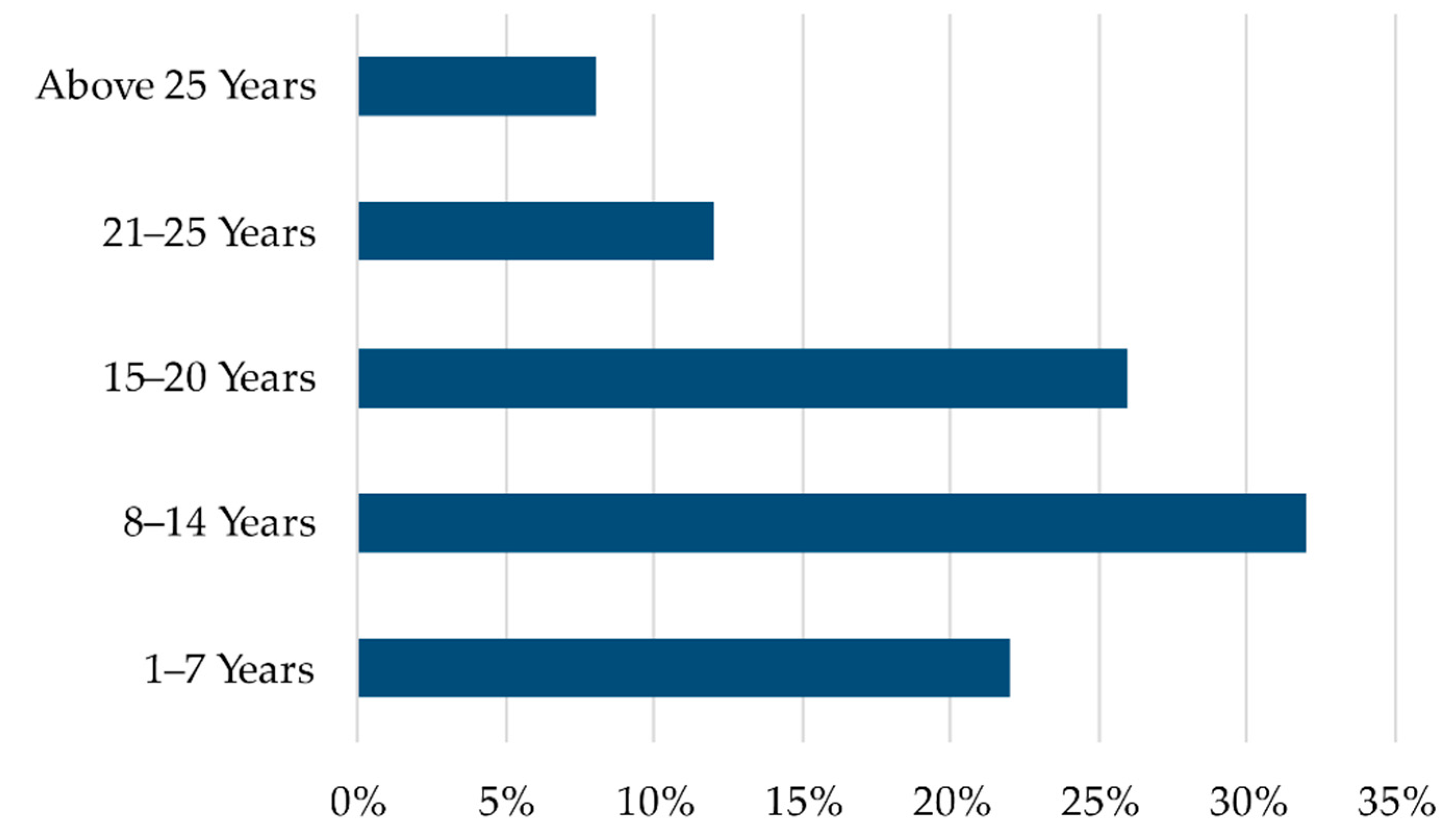
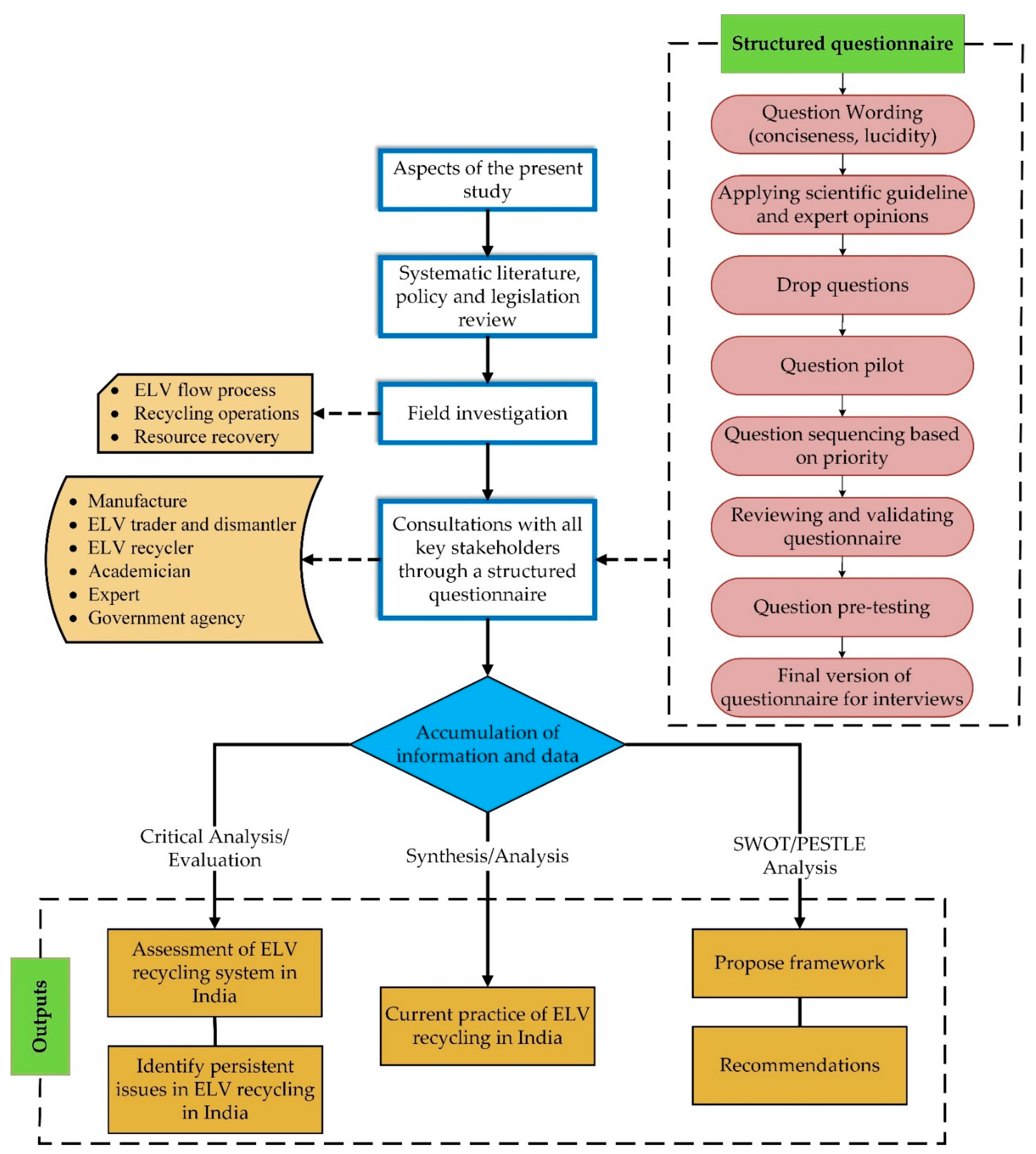
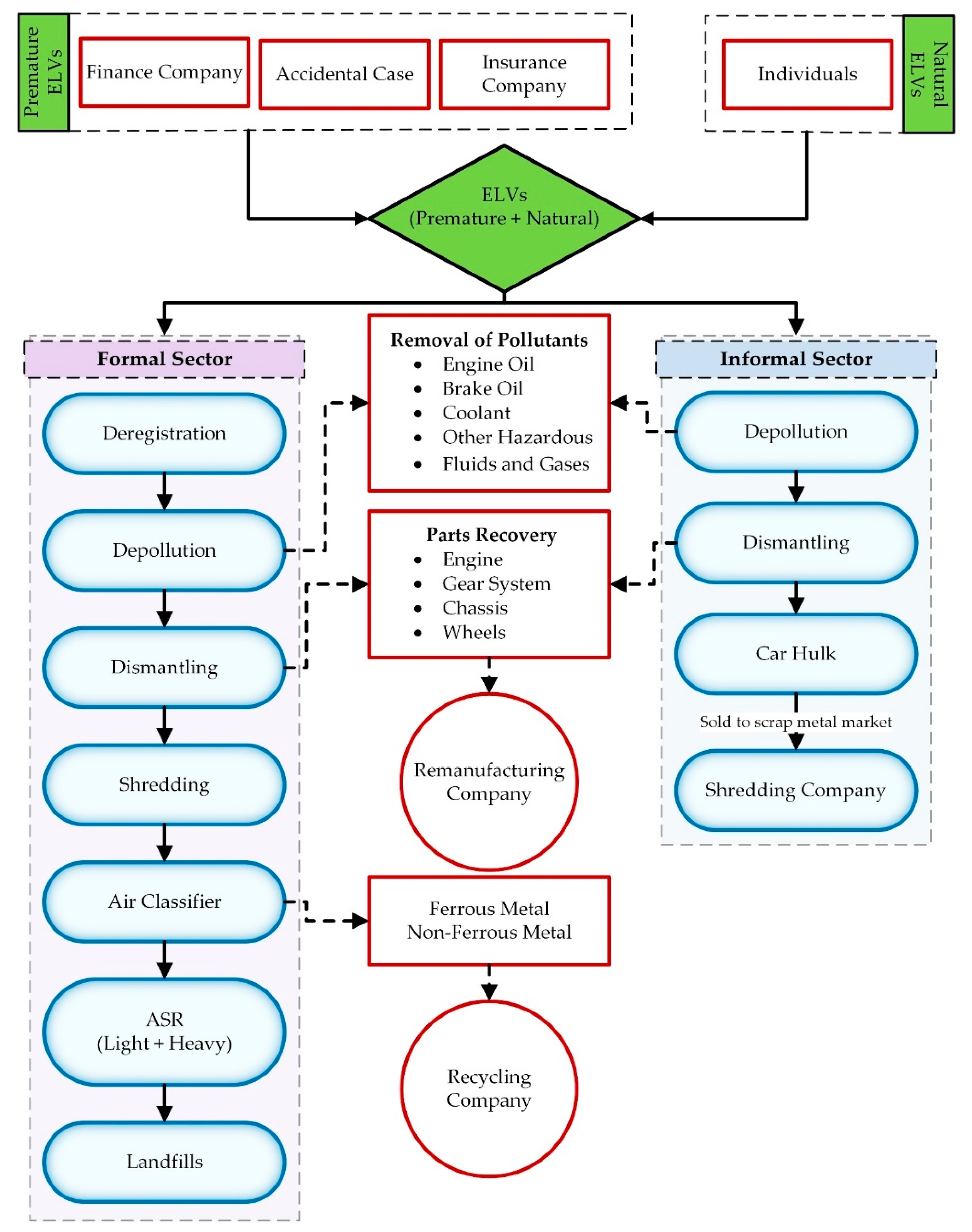

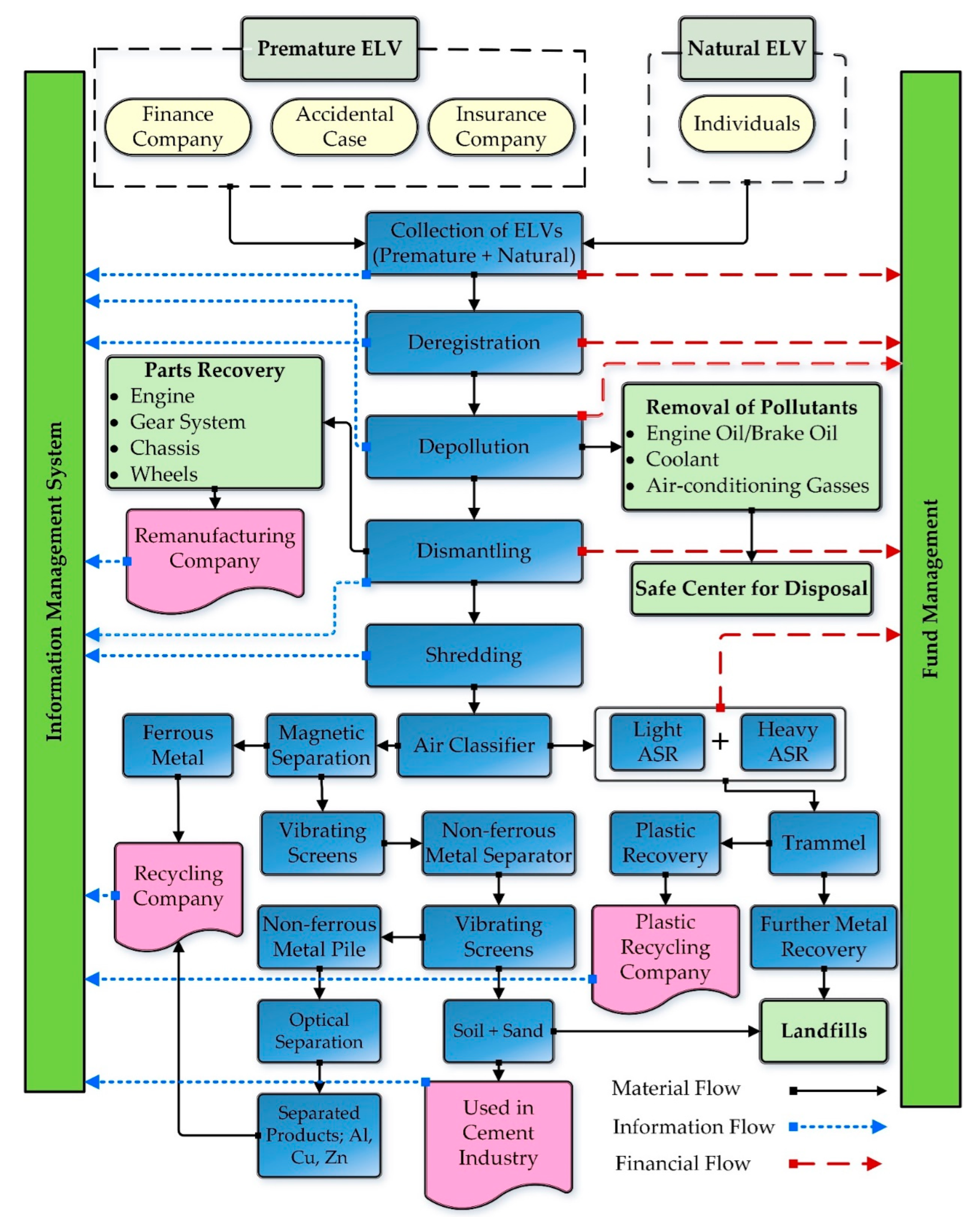
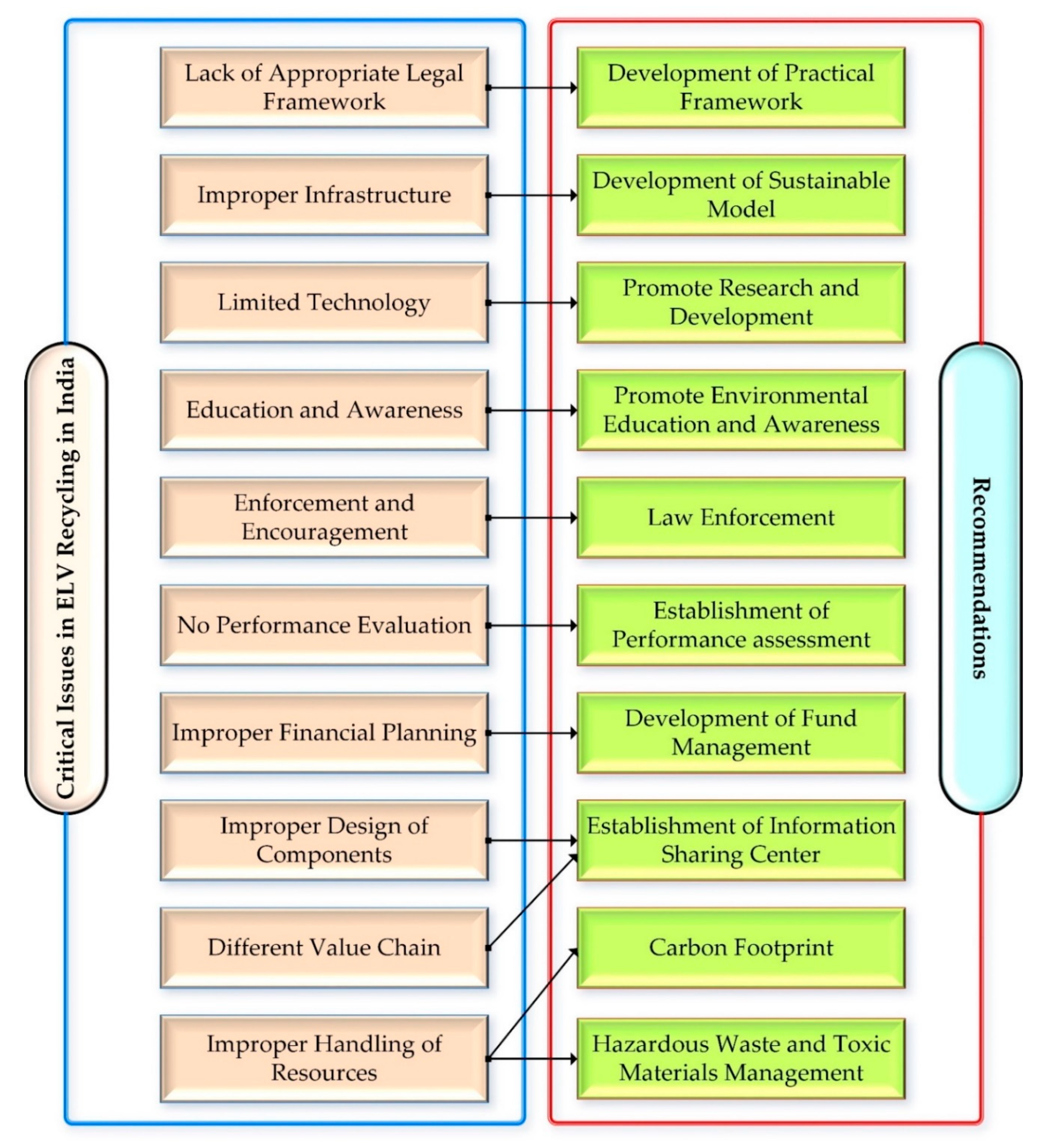
| Category | 2016–17 | 2017–18 | 2018–19 | 2019–20 | 2020–21 | 2021–22 |
|---|---|---|---|---|---|---|
| Passenger vehicles | 3.8 | 4.02 | 4.028 | 3.42 | 3 | 3.6 |
| Commercial vehicles | 0.81 | 0.895 | 1.1 | 0.75 | 0.624 | 0.8 |
| Three-wheeler | 0.78 | 1.02 | 1.27 | 1.1 | 0.614 | 0.75 |
| Two-wheeler | 19.9 | 23.15 | 24.49 | 21 | 18.34 | 17.7 |
| Quadricycle | 0.00158 | 0.001713 | 0.005388 | 0.006 | 0.003 | 0.004 |
| Total | 25.3 | 29.09 | 30.91 | 26.35 | 22.65 | 22.93 |
| Law | Year | Vision/Mission |
|---|---|---|
| Water (Prevention and Control of Pollution) Act | 1974 |
|
| Air (Prevention and Control of Pollution) Act | 1981 |
|
| Environmental (Protection) Act | 1986 |
|
| The Central Motor Vehicles Act | 1988 |
|
| The Hazardous Wastes (Management and Handling) Rules | 1989 |
|
| The Municipal Solid Waste (Management and Handling) | 2000 |
|
| The Ozone Depleting Substances (Regulation and Control) Rules | 2000 |
|
| The Batteries (Management and Handling) Rules | 2001 |
|
| The National Environment Policy | 2006 |
|
| The National Action Plan for Climate Change | 2009 |
|
| The e-waste (Management and Handling) Rules | 2011 |
|
| The Plastic Waste (Management and Handling) Rules | 2011 |
|
| Hazardous and Other Wastes (Management and Transboundary Movement) Rules | 2016 |
|
| Solid Waste Management Rules | 2016 |
|
| Plastic Waste Management Rules (Amendment) | 2016 |
|
| Operation | Equipment |
|---|---|
| Pre-treatments |
|
| Depolluting |
|
| Dismantling |
|
| Shredding |
|
| Depollution Operations | Formal ELV Recycling Sector Managing Sustainably (✔)/ Not (✖) | Informal ELV Recycling Sector Managing Sustainably (✔)/ Not (✖) |
|---|---|---|
| Before Lifting the Vehicles | ||
| Removal of battery | ✔ | ✔ |
| Remove the fuel filter cap and oil filler | ✔ | ✖ |
| Removal of tires and wheels | ✔ | ✔ |
| Removal of parts containing mercury | ✔ | ✖ |
| Air-conditioning gases | ✖ | ✖ |
| Lifting the vehicles on the depollution frame | ||
| Engine oil | ✔ | ✔ |
| Transmission oil | ✔ | ✖ |
| Coolant | ✔ | ✖ |
| Brake fluids | ✔ | ✖ |
| Removal of catalysts | ✖ | ✖ |
| Washer bottle | ✔ | ✖ |
| Brake/clutch reservoirs | ✖ | ✖ |
| Power steering reservoirs | ✔ | ✔ |
| Fuel tank | ✔ | ✖ |
| After removing from the de-pollution frame | ||
| Deploy airbags and other pyrotechnics on-site (if equipped and capable of carrying out this operation). | ✖ | ✖ |
| Eliminate any airbags and pyrotechnics (if fitted and unable to be used in situ). | ✖ | ✖ |
Publisher’s Note: MDPI stays neutral with regard to jurisdictional claims in published maps and institutional affiliations. |
© 2022 by the authors. Licensee MDPI, Basel, Switzerland. This article is an open access article distributed under the terms and conditions of the Creative Commons Attribution (CC BY) license (https://creativecommons.org/licenses/by/4.0/).
Share and Cite
Harun, Z.; Molla, A.H.; Mansor, M.R.A.; Ismail, R. Development, Critical Evaluation, and Proposed Framework: End-of-Life Vehicle Recycling in India. Sustainability 2022, 14, 15441. https://doi.org/10.3390/su142215441
Harun Z, Molla AH, Mansor MRA, Ismail R. Development, Critical Evaluation, and Proposed Framework: End-of-Life Vehicle Recycling in India. Sustainability. 2022; 14(22):15441. https://doi.org/10.3390/su142215441
Chicago/Turabian StyleHarun, Zambri, Altaf Hossain Molla, Mohd Radzi Abu Mansor, and Rozmi Ismail. 2022. "Development, Critical Evaluation, and Proposed Framework: End-of-Life Vehicle Recycling in India" Sustainability 14, no. 22: 15441. https://doi.org/10.3390/su142215441
APA StyleHarun, Z., Molla, A. H., Mansor, M. R. A., & Ismail, R. (2022). Development, Critical Evaluation, and Proposed Framework: End-of-Life Vehicle Recycling in India. Sustainability, 14(22), 15441. https://doi.org/10.3390/su142215441







